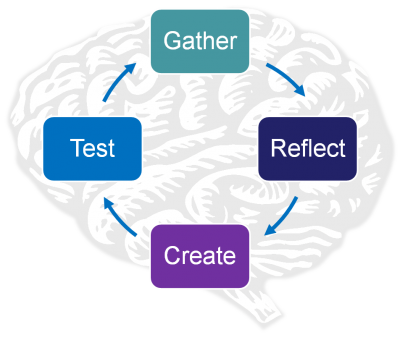 What is really happening in our brain when we learn?
What is really happening in our brain when we learn?The way our brains process information has huge implications for those of us who design corporate training and other adult education experiences. Our awareness of the principles of neuroscience, and their application in "brain-friendly training" can make the difference between a program that is simply enjoyable and one whose content is retained and applied to improve job performance. Improved performance usually brings financial success and recognition by a company that their investment in training was worth it. "In order to achieve the desired ROI on training, we must design and deliver training that becomes integrated into long-term memory," explains John Juzbasich, D.Ed(c), MLD and CEO of Merit Career Development.1
Learning produces physical changes in the brain
What does learning look like?
Research has shown that information we receive goes through four distinct regions of the brain; indeed, using modern imaging techniques we can actually see information moving through the brain.
The four regions are:
- Sensory Region - Information is first filtered here. Incoming data is processed by our five senses. This is the region for gathering information.
- Back Integrative Region - Here, bits of data are connected over time, associations become apparent, and understandings grow. This is where our brain makes meaning of the information we receive by connecting the new information with our past experiences and beliefs. This is the region for reflecting on the information we gathered.
- Front Integrative Region - Here, we consciously manipulate data to plan what we'll do with it. We are creating new ideas.
- Motor Region - This part of the brain sends signals for the body to act on the information it has received. This is the region for testing our understanding.
In addition, there are chemicals in the brain that produce emotions that affect the four regions and hence modify the strength of each step of the learning cycle. According to research by James E. Zull2, professor of Biology and Director of the University Center for Innovation in Teaching and Education at Case Western Reserve University, the frequent firing and exposure to the chemicals of emotion lead to great change in neuronal networks; that change is the physical evidence that learning has taken place.
If learners gather, reflect, create and test, and if their emotions are engaged at each step with fun, memorable activities, they will have used their whole brains!
Now that we know about how the brain learns, how can we produce those physical changes in learners’ brains? How can we maximize their participation to make our training stick?
Gathering
- Keep changing what the learner sees.
- Include as many senses as you can.
- Limit the amount of content to only what is needed, because they will not make sense of the information until subsequent stages.
Reflecting
- Know your audience.
- Provide many opportunities for them to connect the new information and challenges to what they already know and care about.
- Use multiple analogies and examples to help recall of prior knowledge.
- Ask them to put their thoughts into writing, or to predict the outcome of a scenario.
- Learners will attach new things to their existing neuronal networks to generate more complete understanding. Juzbasich says that from the learner’s perspective, what is not connected, or not relevant, gets thrown out!
Creating
- Draw out the connections the learners are making and enable them to create deeper knowledge from the new information.
- Use examples that are relevant and suggest comparisons with their daily work.
- Tell stories that resonate with what’s important to the group. Perhaps ask, "How will you use what you’re learning with your client?" "How did you handle this situation in the past and what has changed now?" "What does this make you think of?"
- These strategies help learners to call upon their prior knowledge and create tests for the new concepts.
Testing
- Offer opportunities for meaningful practice that involve moving the body in some way. Don’t forget, talking is a motor activity. Neurons that fire a lot during activity tend to form more connections and strengthen new connections.
- Don't stop at drilling and repetition, because neurons stop firing when something simply becomes habit.
- Ask learners to share their thoughts with others. Ask progressively more complex questions.
- Have pairs or groups act out a scenario; play increases retention.
- Provide simulations that engage them and test whether their understanding of the information will be adequate in the "real world."
- Provide encouragement and feedback.
Merit Career Development offers professional courses planned with close attention to how learners’ brains work. Every in-person, web conferencing, or computer-based experience can be customized for your specific situation and can incorporate elements from your workplace. Review some of our offerings and contact us to learn more.
References
1 Juzbasich, John, D.Ed(c), MLD “Make Training Stick”, American Society for Training and Development Philadelphia Chapter Meeting, King of Prussia, PA, March 12, 2014, (Invited Speaker).
2Zull, James E., "The Art of the Changing Brain"
Fernandez, Alvaro. "The Art of Changing the Brain: Interview with Dr. James Zull"

 Within every organization, employees range in personality types from professionally outgoing to socially reserved. Managing a mix of extraverts and introverts can be a challenge, but encouraging each personality type’s strengths and encouraging both groups to understand these dynamics is key.
Within every organization, employees range in personality types from professionally outgoing to socially reserved. Managing a mix of extraverts and introverts can be a challenge, but encouraging each personality type’s strengths and encouraging both groups to understand these dynamics is key.
 Although the wrong frame in the wrong situation can lead to bad decisions, using the right frame can be beneficial in closing sales with prospective customers.
Although the wrong frame in the wrong situation can lead to bad decisions, using the right frame can be beneficial in closing sales with prospective customers.